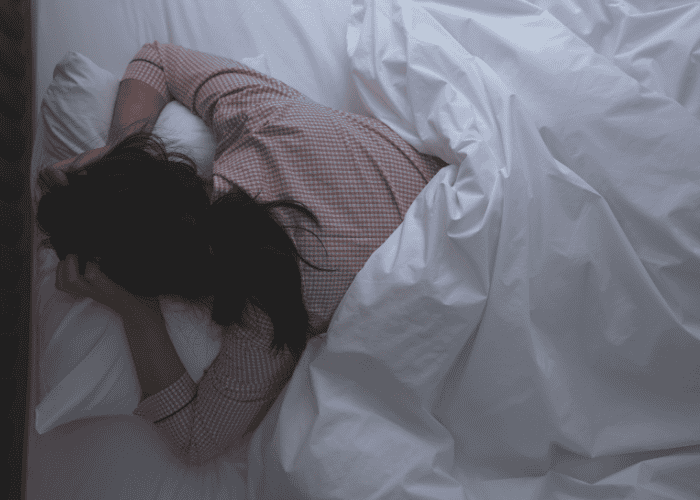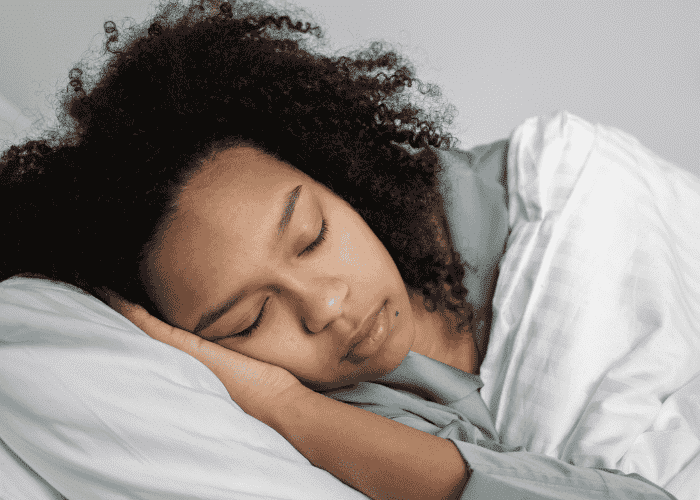Teen insomnia: Causes, Risks, and Treatment Options

Imagine climbing into bed exhausted after a full day of classes, clubs, and homework. You can’t wait to get some sleep. But as the minutes tick by, your mind is still racing. You begin to worry that you’ll never fall asleep, and that if you don’t get to sleep soon, you’ll be miserable all the next day. Then you think about how this keeps happening. The more you think about how important it is to get to sleep soon, the more impossible it seems, and the more distressed you become.
If this sounds familiar and you frequently struggle to get enough rest, you could be experiencing insomnia. Insomnia is common among teens, and it can take a serious toll on your health and quality of life.1 In this article, you’ll find out:
- Signs and symptoms of insomnia
- Risks of untreated teen insomnia
- Potential causes and risk factors
- Coping and prevention strategies
- Effective treatment options

What Is Teen Insomnia?
Insomnia is a sleep disorder that involves difficulty falling asleep or staying asleep. If you struggle with insomnia, you may not get to sleep until the early hours of the morning, wake up too early, and feel tired throughout the day.
As such, insomnia can seriously impact your mental and physical health and ultimately have severe consequences on your quality of life.
Symptoms of Teen Insomnia
If you struggle with sleep, you may be wondering if you have insomnia and what to do about it. Symptoms of insomnia include:2
Difficulty falling asleep or staying asleep, even though you have the opportunity. For a healthy person, it usually takes under 30 minutes to fall asleep. If it takes longer – so long that you feel frustrated and stressed – it could be a sign of insomnia.
Note that this is different from being unable to get enough sleep because you’re at a football game or working late. Insomnia involves having a hard time getting enough sleep, even when you’re home and get to bed at a decent hour.
Your sleep is not restful. When you do fall asleep, do you wake up feeling restored and refreshed? Or do you feel like your mind raced all night long even though your eyes were closed? Did you wake up several times? If your sleep does not recharge you, you may be dealing with insomnia.
Sleep difficulties negatively impact your daytime life. Do you find yourself snapping at your friends, falling asleep during class, or forgetting things frequently because you’re so tired?3 Insomnia involves daytime consequences from poor sleep.
Sleep difficulties are frequent and long-term. Insomnia is defined as sleep difficulty that occurs at least three times a week for at least one month. So, if you find yourself struggling to sleep often, this could be a sign of insomnia.
Although insomnia is common among adolescents, it is not “just a normal part of growing up.”1 It is a sleep disorder, and it can severely affect your quality of life. It can also lead to a number of serious physical and mental health problems.
Long-Term Impact of Insomnia in Teens
It’s important not to dismiss teen insomnia as “just a little trouble falling asleep.” Any sleep disorder, including insomnia, can put you at a heightened risk for serious mental and physical health complications. To highlight the importance of treating insomnia, below we explore some risks of long-term, untreated insomnia.
Insomnia is associated with increased likelihood of:
- Suicidal tendency1,4
- Risk-taking behaviors, like drunk driving or drug use1
- Depression4
- Anxiety4
- Poor school performance5
- Obesity5
- Increased accident and injury rates5
- Negative mood5
- Reduced emotional regulation5
Main Causes of Insomnia in Adults
Use of Electronic Devices Near Bedtime
Bright lights from electronic screens delay the release of melatonin. Melatonin is a hormone that plays a key role in falling asleep, so this delay can make it more difficult to catch your Zs.6
Stimulation from electronic devices, such as social media or text interactions, can “increase pre-sleep arousal levels.” In other words, these activities may “wind you up” when it’s time to “wind down.” To fall asleep, your brain needs some time without stimulation.1
Consuming Psychoactive Substances
Caffeine causes physiological arousal (meaning it puts your body in “alert mode”) and is associated with a 1.9 times higher likelihood of sleep difficulties, according to recent studies.6
Caffeine use around bedtime can also cause a negative feedback loop. For example, you feel tired after a poor night’s sleep due to caffeine use, which makes it tempting to drink more caffeine to fend off the tiredness. This, in turn, can lead to another poor night’s sleep.
Alcohol, nicotine, or marijuana have also all been linked to increased insomnia complaints.1
High Levels of Stress
A growing body of research suggests that stress increases the risk of insomnia in adolescents. Common stressors for adolescents include:
School stress- Pressure to balance school, extracurricular obligations, and social demands
- Parental conflict
- The parent-adolescent relationship
Coping Strategies for Insomnia in Teens
Studies show that programs promoting healthy sleep habits and raising adolescent mental health awareness about the potential consequences of poor sleep can help prevent the onset of insomnia.1
However, you can also take matters into your own hands and educate yourself on sleep hygiene as a way to support any treatment program you choose.
Here are ten science-based steps that you can take to optimize your sleep:6
Go to bed and wake up at roughly the same time each day, even on non-school days.- Turn off your electronics an hour before you plan to go to bed. Silence your phone to reduce the temptation to respond to messages or check social media.
- Get regular exercise early in the day.
- Avoid caffeine, especially six hours before bedtime.
- Stop eating one to two hours before bedtime.
- Dim your lights in the hour before bedtime so your body can start releasing melatonin.
- Cool your room before sleep to around 60-67 degrees Fahrenheit.
- If you get into bed and cannot fall asleep within thirty minutes, get back up. Try relaxation techniques for teens, write in a journal, read, and then try again later.
- Use your bed only for sleeping. Do not watch TV, do homework, or use your phone in bed.
- Seek professional help early if you experience anxious thoughts about sleeping. Thoughts like, “I need to fall asleep right now or I’m not going to be able to function tomorrow,” can exacerbate sleep issues. Therapy for sleep disorders can be an effective way to develop healthier thoughts about sleep and reduce insomnia symptoms.
Early Intervention for Sleep Disorders
Therapy for Sleep Disorders
Research shows that cognitive behavioral therapy for insomnia (CBT-I) is safe and effective in improving insomnia in adolescents.4 Studies show that CBT-I may also help teens with managing anxiety and sleep, as well as depression. CBT-I involves sleep education, sleep restriction therapy, cognitive therapy, and relaxation techniques to help with stress-related sleep issues.6
Medication for Teen Insomnia
Pharmacotherapy, or medication therapy, may include benzodiazepines, remelteon, melatonin, or suvorexant. These medications have been found to treat insomnia effectively. However, there is a risk of side effects, dependence, tolerance, and a return to insomnia when you stop taking such medications.4

Get Support With Teen Insomnia at Mission Prep
At Mission Prep, we understand the impact of poor sleep on teens’ quality of life. Insomnia can leave you feeling frustrated, stressed, and exhausted. And it can be challenging to improve symptoms on your own. Our team of professionals is here to support you.
Through our outpatient mental health program, intensive outpatient mental health program, or our summer program, we offer a nonjudgmental, compassionate space to explore what could be at the root of your insomnia. We will work with you to create a personalized, sustainable plan to help you now and long into the future.
If you’re tired of struggling to fall asleep, give us a call or fill out our contact page—we are ready to support you on your journey to better rest and mental health.
References
- De Zambotti, M., Goldstone, A., Colrain, I. M., & Baker, F. C. (2017). Insomnia disorder in adolescence: Diagnosis, impact, and treatment. Sleep Medicine Reviews, 39, 12–24. https://doi.org/10.1016/j.smrv.2017.06.009
- Roth, T. (2007, August 15). Insomnia: Definition, Prevalence, etiology, and Consequences. https://pmc.ncbi.nlm.nih.gov/articles/PMC1978319/#sec2
- Holder, S., & Narula, N. S. (2022, April 15). Common Sleep Disorders in Adults: Diagnosis and management. AAFP. https://www.aafp.org/pubs/afp/issues/2022/0400/p397.html#:~:text=Chronic%20insmnia%20is%20classified%20as,9
- Mei, Z., Cai, C., Luo, S., Zhang, Y., Lam, C., & Luo, S. (2024). The efficacy of cognitive behavioral therapy for insomnia in adolescents: a systematic review and meta-analysis of randomized controlled trials. Frontiers in Public Health, 12. https://doi.org/10.3389/fpubh.2024.1413694
- Matthews, K. A., Hall, M. H., Cousins, J., & Lee, L. (2015). Getting a good night’s sleep in adolescence: Do strategies for coping with stress matter? Behavioral Sleep Medicine, 14(4), 367–377. https://doi.org/10.1080/15402002.2015.1007994
- Markwald, R. R., Iftikhar, I., & Youngstedt, S. D. (2018). BEHAVIORAL STRATEGIES, INCLUDING EXERCISE, FOR ADDRESSING INSOMNIA. ACSMʼs Health & Fitness Journal, 22(2), 23–29. https://doi.org/10.1249/fit.0000000000000375













